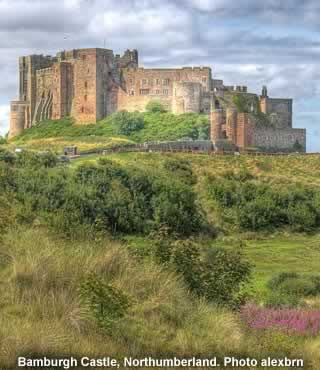Northumberland |
|
 |
|||
A northern, mainly rural county which borders Scotland to the North and often called the Cradle of Christianity |
Listen to this article |
Northumberland is a county of England located in the north east of the country. It borders Scotland to its north and also has nearly 129 kilometres of coastline. The county town is Alnwick although the county council is located in Morpeth. It is the most sparsely populated county in England with only 62 people per square kilometre. |
Historically the 'Kingdom of Northumbria', under the ruling of King Edwin, stretched from as far as the Humber in the south to the Scottish River Forth in the north. These boundaries encompass Newcastle upon Tyne, the county town until 1974. Being located on the border of Scotland and England, Northumberland has been the location for many battles between the bitter neighbours. The area was once part of the Roman Empire and its varied and often bloody history is reflected in the fact Northumberland has more castles than any other county in England! These include the castles at Bamburgh, Dunstanburgh and Alnwick; which was the residence of the Duke of Northumberland, and one of the highlights of the county. It was at Alnwick castle that legendry TV character Blackadder first stepped in front of the camera and British comedy has not looked back since! |
Northumberland is often called the 'cradle of Christianity' in England because it has within Lindisfarne, a site of special Christian significance. This tidal islet, also known as Holy Island, was the location for the settlement of the monks from Iona, who came to convert the English. Christianity flourished in the region as a result of their efforts and the island is home to the world famous Lindisfarne Gospels, illuminated Latin manuscripts of the four New Testament books. They were reportedly made in honour of fellow Lindisfarne resident St Cuthbert, who is buried at Durham Cathedral. Cuthbert was one of England's most important medieval Saints and is regarded as the Patron Saint of Northumberland. Holy Island is a place of not only historic and religious significance but also of stunning natural beauty and should definitely on the itinary of any visit to this region. |
The county is also famous for its beautiful high moorlands, the inspiration to countless landscape painters. Around a quarter of the county is protected within the Northumberland National Park, which stretches southwards from the Scottish Borders and includes the Roman built Hadrian's Wall, another of Northumberland's key attractions and now a UNESCO World Heritage Site. Most of the Park is over 800 feet above sea level but also includes breathtaking areas of coastline. The physical geography of the county reflects the varied topography of the landscape; from the Devonian granite of the north-western hilltops to the igneous Dolerite outcrops of Farne Island- famous for its bird life. |
Northumberland is also celebrated for its unique cultural heritage, much of which isn't found elsewhere in England. Traditions include the rapper sword dance, the Clog dance and the playing of the Northumbrian smallpipe. The county also has its own tartan, commonly referred to as Shepherd's Tartan. Its renowned too for its 'Boarder ballads', exclusive to the region. |
Under populated, scenically spectacular and with a distinct blend of English and Scottish culture, Northumberland is unlike any other county in England. Well worth a visit and a wonderful place to spend a day or two- wondering the hills, breathing in the fresh sea air and absorbing its long and varied history. |
|
Pocket Britain is optimised for use on a smartphone or tablet with internet access. All content is subject to copyright. All reasonable methods have been used to ensure information supplied is accurate at the time of publication. However, it is advisable to check information before relying on it. Privacy Policy |